Today’s article features a bit of a different combo deck. It is not the most straightforward deck in Legacy, nor is it entirely predictable in how it kills people.
This deck’s nonlinearity is actually a big upside, as it can be tiresome to play with or against a deck that has the same three lines of play in every single situation. How many times can you realistically stomach this?
“Show and Tell.”
[sigh] “Okay.”
“Put in (Emrakul, the Aeons Torn / Griselbrand / Omniscience / Sneak Attack).”
“Can’t beat it.”
End scene.
While many combo players prize consistency and redundancy, there is a lot to recommend a combo deck with more branches in its decision tree. By having so many possibilities on every turn, it becomes harder to develop tunnel vision. When you have more ways to win, you have to be more thorough in your thought processes. In other words, nonlinear combo decks train you to be smarter.
Also, added bonus: they’re really fun to play.
The deck I’m writing about today is a product of someone else’s creative process. CJ Lack reached out to me with a Possibility Storm[/author]“][author name="Possibility Storm"]Possibility Storm[/author] deck that casts Enter the Infinite and Emrakul, the Aeons Torn, and I couldn’t resist bringing it to you all. It’s too sweet.
To start with, his deck:
Creatures (5)
Planeswalkers (4)
Lands (18)
Spells (33)
- 4 Brainstorm
- 4 Force of Will
- 4 Accumulated Knowledge
- 4 Intuition
- 4 Lotus Petal
- 4 Gitaxian Probe
- 4 Izzet Charm
- 1 Enter the Infinite
- 4 Possibility Storm
Sideboard

I admire CJ Lack (cjlack92 on MODO) for the way he approaches deckbuilding. He created (and constantly innovated) a four-color Burn at the Stake combo deck while Innistrad was Standard-legal. That deck, like this one, is a nonlinear combo deck – the deck could often win, but that outcome would seldom be obvious at the start of the turn. When CJ reached out to get feedback on his Possibility Storm[/author]“][author name="Possibility Storm"]Possibility Storm[/author] deck, I was excited to see it in action.
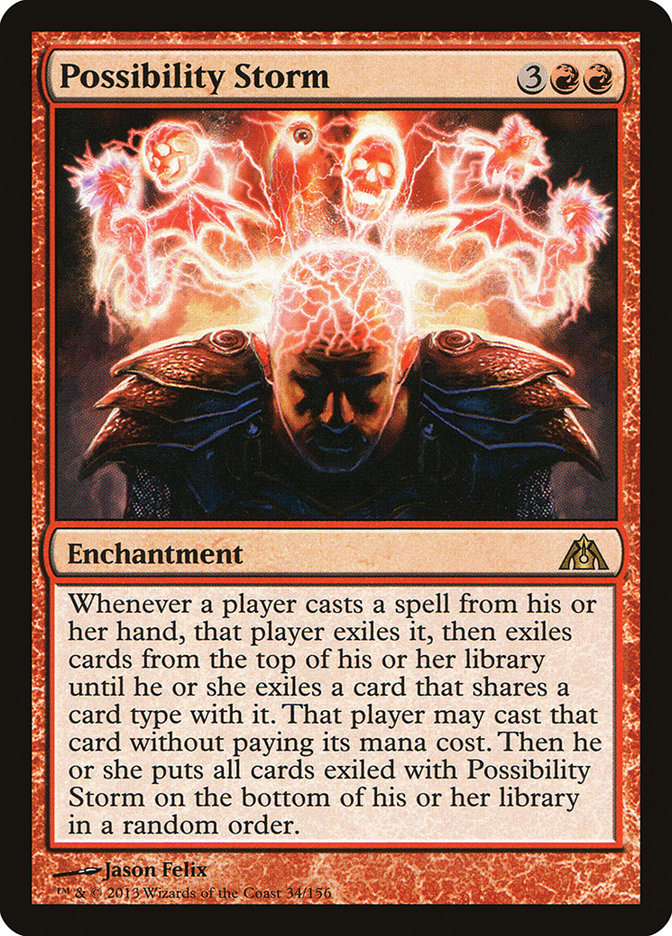
I wasn’t disappointed.
As someone who has never played in a paper Legacy event, CJ’s process for creating the deck diverges from a more traditional, metagame-based deckbuilding approach.
To be clear, his idea for making the deck was to try to break Magic Online’s interface. Go nuts with this joke setup.
Although CJ originally had Blightsteel Colossus in the deck, he realized that the problems it created exceeded the problems it solved. Realistically, it only really solved an opponent Possibility Storming into an Ethersworn Canonist, while its presence would clog up an otherwise-streamlined draw engine. Emrakul, the Aeons Torn is the best card to flip over, so junking up your deck with creatures that don’t kill them immediately is bad for business.
We’ll return to CJ’s insights in a bit, but let’s break down the decklist first.
Let’s talk about how Possibility Storm[/author]“][author name="Possibility Storm"]Possibility Storm[/author] works before we get into anything else.
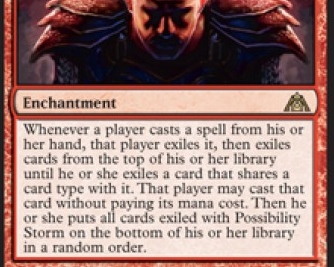
Some basic rules to keep in mind:
- This is symmetrical. I know that’s a weird place to start, but the first time I read Dream Halls, I didn’t realize it was symmetrical and almost lost the game because of my ignorance and arrogance.
- When you cast a spell, Possibility Storm[/author]“][author name="Possibility Storm"]Possibility Storm[/author] creates a trigger. Your spell remains on the stack until the moment this trigger resolves.
- If your Possibility Storm[/author]“][author name="Possibility Storm"]Possibility Storm[/author] trigger somehow ends up getting Stifled, you keep the spell you’re casting.
- If your spell somehow ends up getting countered, your Possibility Storm[/author]“][author name="Possibility Storm"]Possibility Storm[/author] trigger will still resolve. If Possibility Storm[/author]“][author name="Possibility Storm"]Possibility Storm[/author] finds a spell that shares a type with the (now-countered) spell, you’ll still get to cast that one. Possibility Storm[/author]“][author name="Possibility Storm"]Possibility Storm[/author] remembers what type of spell you had.
- If you don’t have a match, you basically end up shuffling your spell into your deck.
- This means that as long as you have castable spells, you can’t really lose to decking with Possibility Storm[/author]“][author name="Possibility Storm"]Possibility Storm[/author] in play.
- Your opponents’ Miracles won’t work especially well.
- Possibility Storm[/author]“][author name="Possibility Storm"]Possibility Storm[/author] usually kolds opposing spell-based combo decks.
- Possibility Storm[/author]“][author name="Possibility Storm"]Possibility Storm[/author] doesn’t counter, it exiles. Uncounterable spells still end up on the bottom of their owner’s deck instead of resolving.
Now that we understand how our deck’s namesake card works, what about the rest of the deck? There are quite a few cards that look out of place.
My first question was “Why are you playing Sandstone Needle and Saprazzan Skerry over Ancient Tomb and City of Traitors?” Many Legacy veterans would also wonder at the inclusion of the Mercadian Masques depletion lands in a deck dedicated to casting a five-mana enchantment. After all, every deck trying to cast Sneak Attack, Dream Halls, and Hive Mind plays some number of Ancient Tombs or City of Traitors – why is this deck the exception?
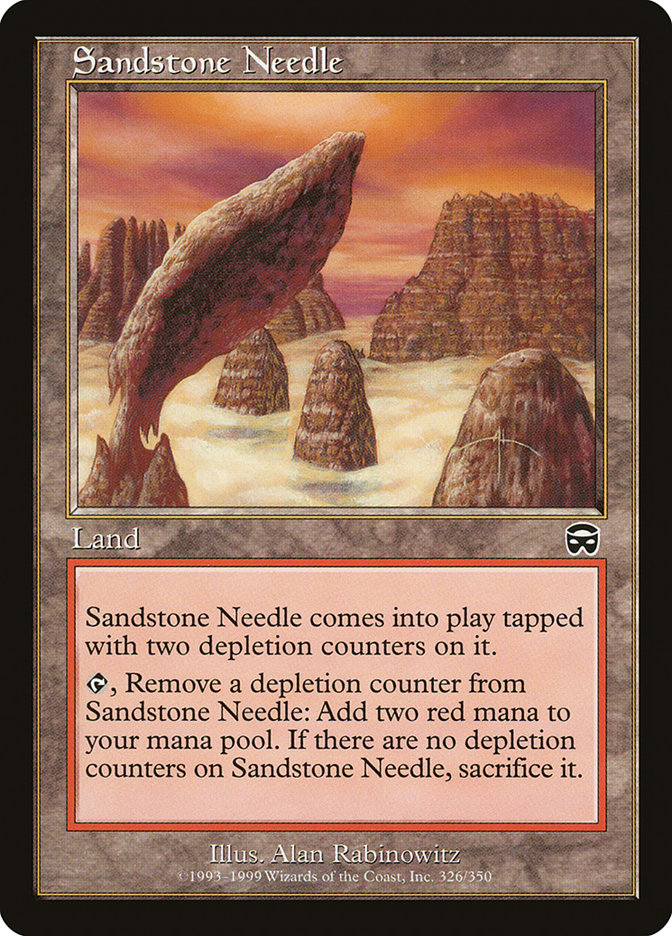
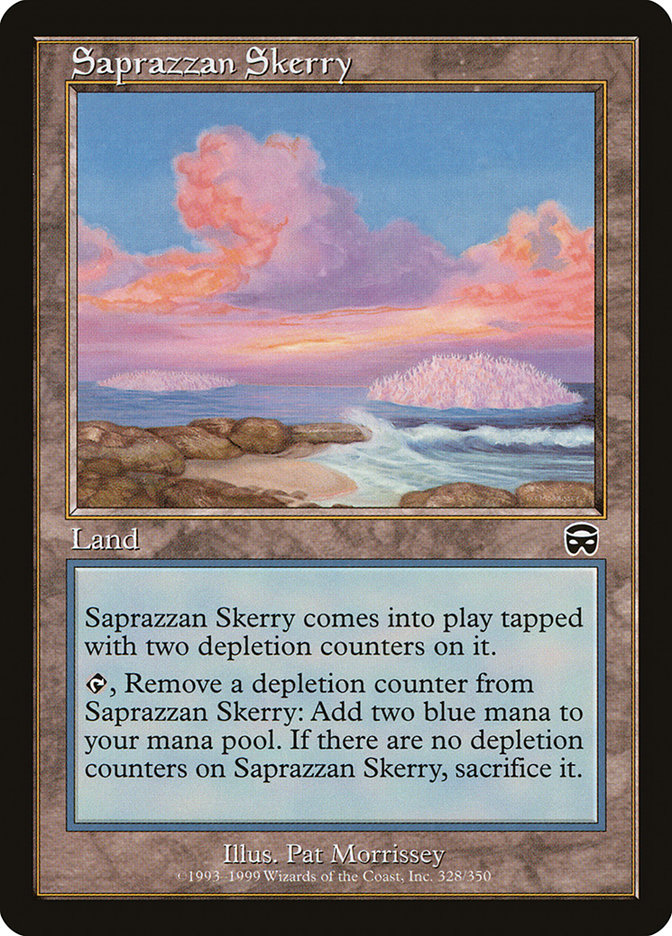
The lack of Show and Tell combined with Jace, the Mind Sculptor’s double-blue and Possibility Storm[/author]“][author name="Possibility Storm"]Possibility Storm’s[/author] double-red requirements pushed CJ away from the fast colorless mana and toward the Masques lands. His thought process is good: if you’re not trying to assemble Show and Tell + Thing + Island + Sol Land, there are better ways to get to five color-intensive mana.
The natural follow-up, of course, is “Why aren’t you playing Show and Tell?”
There is one obvious answer – “it only has four things to put into play” – and another answer that reveals the thought that went into this deck.
As you may have noticed, there is a glaring absence of Ponder and Preordain in this blue combo deck. There is a very good reason for that.
There are, in fact, only five sorceries in the entire deck: four Gitaxian Probe and one Enter the Infinite. Although this deck can assemble Possibility Storm[/author]“][author name="Possibility Storm"]Possibility Storm[/author] + Emrakul, the Aeons Torn on top of the deck + Simian Spirit Guide, the true kill is a bit more complicated.
Step one is to play some Magic. Cast spells, play lands, resolve a Jace, the Mind Sculptor. Cast some more spells. Cast Gitaxian Probe at some point.
After you’ve cast exactly one Gitaxian Probe, cast Intuition for the other three.
Cast Possibility Storm[/author]“][author name="Possibility Storm"]Possibility Storm[/author], and then cast (and exile) your last Probe. Exile your deck until you hit Enter the Infinite. Cast that. Draw your deck. Put back your Emrakul.
Cast a Lotus Petal and put it on the bottom with Possibility Storm[/author]“][author name="Possibility Storm"]Possibility Storm[/author], as you have no artifacts in your deck.
Cast a second Petal, casting the first.
Get three Lotus Petals into play. Your library is now Emrakul, the Aeons Torn and Lotus Petal.
Cast Simian Spirit Guide, casting Emrakul, taking another turn.
Draw a card, attack with Emrakul. They should generally be dead at this point.
Possibility Storm[/author]“][author name="Possibility Storm"]Possibility Storm[/author] forces you to consider every card in your deck – while Ponder and Preordain are typically good cards for a combo deck, they would destroy an important option for this deck’s kill mechanism.
Any combo deck still needs card selection, though, and Ponder/Preordain are the best at what they do. How can a blue combo deck forgo such powerful cards and still remain viable?
We play four Accumulated Knowledge, four Intuition, and four Jace, the Mind Sculptor, that’s how. The Intuition/AK engine was once the greatest draw engine in Magic, and this deck can leverage every part of it. The deck can use Intuition to find Possibility Storm[/author]“][author name="Possibility Storm"]Possibility Storm[/author] or Gitaxian Probe, it can lean on Accumulated Knowledge to play a longer game against control, and it can lean on a fast Jace, the Mind Sculptor to bury combo and control opponents.
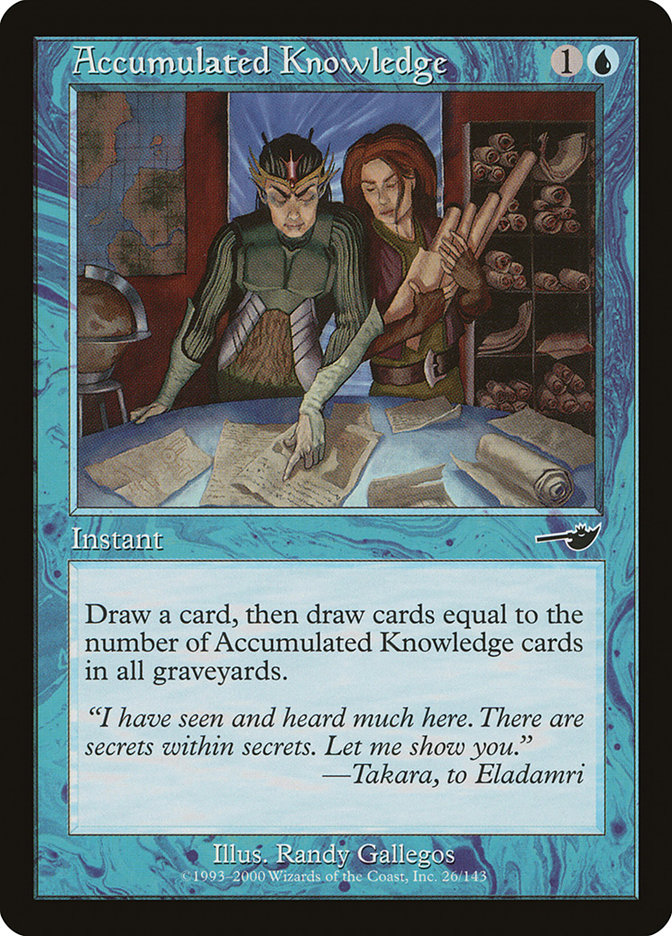
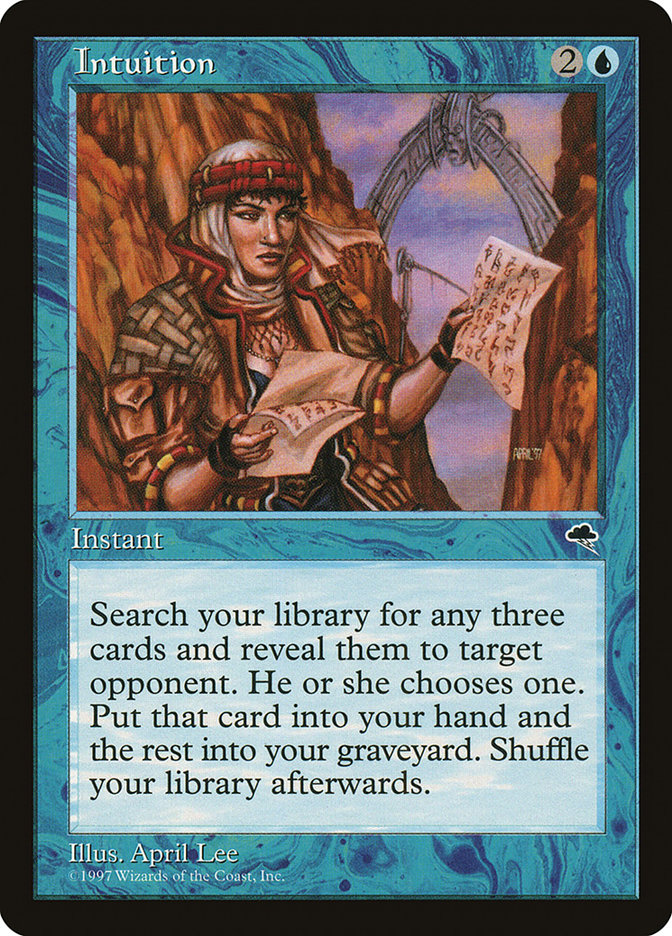

The drawback, of course, is that it makes our combo deck even worse against Delver of Secrets. When your combo costs five and you don’t have City of Traitors, you’re going to be slower. When your card selection spells cost two, three, and four instead of one and one, you’re going to be slower. When you’re slower, your tempo matchup gets worse. Unfortunately, I don’t have much to tell you on that front – this deck isn’t going to be great against Delver decks.
What this deck loses against tempo, though, it gains against combo, control, and midrange decks. Being able to play a longer game against decks with discard spells and counterspells and Jaces is a Big Deal. Being able to not only compete with, but actually out-draw blue opponents? Even better.
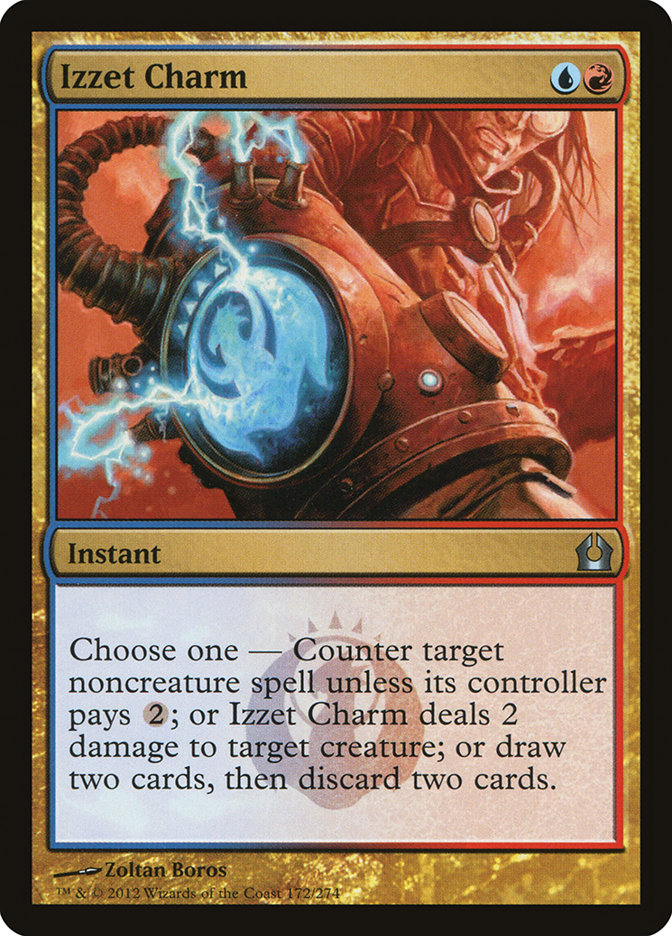 Izzet Charm provides three very relevant modes – it can dig to Possibility Storm[/author]“][author name="Possibility Storm"]Possibility Storm[/author], it can fight over important spells, and it can kill Delver of Secrets, Thalia, Guardian of Thraben, Ethersworn Canonist, and Deathrite Shaman. This may be the first deck that genuinely wants all three of Izzet Charm’s modes, as other blue and red combo decks tend to want speed over utility. Since this deck doesn’t want Ancient Tomb or City of Traitors, it can afford to play more color-intensive cantrips. Since this deck is built for a longer game, it wants cards with more utility. Since it has a robust draw engine in Intuition + Accumulated Knowledge, it can afford to cast Izzet Charm as Careful Study. Without those contributing elements, Izzet Charm’s inclusion would be suspect.
Izzet Charm provides three very relevant modes – it can dig to Possibility Storm[/author]“][author name="Possibility Storm"]Possibility Storm[/author], it can fight over important spells, and it can kill Delver of Secrets, Thalia, Guardian of Thraben, Ethersworn Canonist, and Deathrite Shaman. This may be the first deck that genuinely wants all three of Izzet Charm’s modes, as other blue and red combo decks tend to want speed over utility. Since this deck doesn’t want Ancient Tomb or City of Traitors, it can afford to play more color-intensive cantrips. Since this deck is built for a longer game, it wants cards with more utility. Since it has a robust draw engine in Intuition + Accumulated Knowledge, it can afford to cast Izzet Charm as Careful Study. Without those contributing elements, Izzet Charm’s inclusion would be suspect.
Finally, let’s talk a bit more about the manabase. CJ acknowledged to me that it is far from perfect – his goals were to have fast mana that produces colored mana, some basic lands to fetch against Wasteland decks, and enough fetchlands to make Brainstorm good.
He has eight blue fetchlands and six fetchable lands, so he’s unlikely to run out of lands to put into play. He has four Masques depletion lands that he wants to see early, and I agree with that number. Consider that number in the context of Sneak Attack’s three-to-four Ancient Tombs and think about how the deck wants to cast four double-blue and four double-red spells. Within that context, the Skerry/Needle split makes a lot of sense.
The Underground Sea is a card that we’ll discuss in a bit, along with the sideboard. I don’t think the deck wants more than two Volcanic Islands and I also don’t think the deck needs more than three basic lands. The mana is good enough to have a splash for some sideboard cards, and black offers quite a bit. There are, as you will see, other options to consider.
The four Lotus Petals and four Simian Spirit Guides are also part of the deck’s manabase. They – along with the Skerrys and Needles – allow for faster Jaces and Possibility Storm[/author]“][author name="Possibility Storm"]Possibility Storms[/author]. Any card used to speed up a Jace will, generally, replace itself, since every extra turn that you have Jace in play is another free Brainstorm.
The Brainstorms and Force of Wills are industry standard for blue combo decks.
The Sideboard
When CJ sent me the deck, he included a very basic sideboard with obvious cards against basic hate cards. Pyroblast comes in against counterspells, Hydroblast comes in against Goblin Lackey, Sneak Attack, and Pyroblast. Perish comes in against Gaddock Teeg and Heritage Druid. Massacre comes in against Thalia, Guardian of Thraben and Ethersworn Canonist. Pithing Needle comes in against Sensei’s Divining Top and various other nuisances.
There’s nothing wrong with that sideboard. It answers their answers, which is the way that most combo sideboards function. It’s nothing to write home about.
But it doesn’t take advantage of this deck’s elegance.
You see, this deck is The One We’ve Been Looking For. You know the one.
It is the combo deck that is compact enough to transform.
If you took away the Simian Spirit Guides, the Lotus Petals, the Possibility Storm[/author]“][author name="Possibility Storm"]Possibility Storms[/author], and the one-ofs, you would be left with the following 46 cards:
2 Saprazzan Skerry
2 Sandstone Needle
4 Polluted Delta
4 Scalding Tarn
2 Volcanic Island
1 Underground Sea
2 Island
1 Mountain
4 Gitaxian Probe
4 Brainstorm
4 Accumulated Knowledge
4 Izzet Charm
4 Intuition
4 Jace, the Mind Sculptor
4 Force of Will
Nothing about that list of cards tells me that we have to be a combo deck. There are certainly some cards that are suboptimal in a control deck, but we aren’t trying to play a Painter/Grindstone strategy with Narcomoebas left in our deck.
This is a deck that could have a sideboard of four Tarmogoyf, four Delver of Secrets, four Pyroblast, and three Tropical Island to complement a maindeck singleton. We could even board in Young Pyromancer! How many people are keeping in their Swords to Plowshares against a Possibility Storm[/author]“][author name="Possibility Storm"]Possibility Storm[/author] deck? How many people want an instant-speed Lava Spike against combo?
The incentive to a transformational sideboard is the ability to present a dominant strategy against people whose sideboard would otherwise beat us. We aren’t going to transform against combo decks, as a quick Possibility Storm[/author]“][author name="Possibility Storm"]Possibility Storm[/author] can shut down a lot of combo decks in Legacy.
Since we don’t play any maindeck creatures, it stands to reason that people will sideboard out their creature interaction. It therefore makes sense for us to board in the cheapest, hardest-hitting creatures we can summon.
On a subtler level, we are also going to need to dedicate multiple sideboard slots to hard mana sources. Part of our sideboard plan involves cutting eight “fast” mana sources – four Simian Spirit Guides and four Lotus Petals. As a result, we are left with only eighteen lands. Four of those come into play tapped and don’t stick around very long. We will need to cast our spells. Some of our sideboard cards have to be real lands.
The maindeck draw engine and all four Jaces is a huge incentive to try to transform. This deck can out-card a lot of midrange and control decks. Why wouldn’t we want to push that angle?
I want to hear from you, dear reader. This deck is too rich with possibility to not play, but I’m only one mind. I am confident that together, we can come up with a configuration of this deck that is not only cool, but actually good.
And, if nothing else, it’s going to be really fun to show you guys this deck on video next week.
I look forward to hearing from you in the comments and on Twitter. If you want to get in touch with CJ on Twitter, his handle is @revo_.
Until next week,
@drewlevin on Twitter
